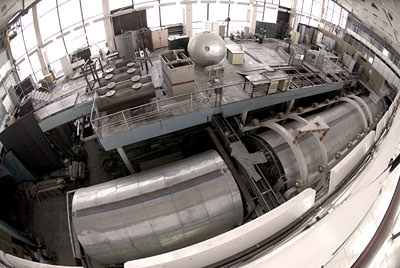[/caption]
Six crewmembers emerged from 105 days of isolation on Tuesday, completing a simulated Mars mission. This experiment was the first phase of the Mars 500 program to help understand the psychological and medical aspects of long spaceflights. “We have successfully completed our mission,” said crew member Oliver Knickel. “This is a big accomplishment that I am very proud of. I hope that the scientific data we have provided over the last months will help to make a mission to Mars possible.”
The simulated mission began on March 31 of this year. Inside the isolation facility in Moscow, Russia the crew participated in a range of scenarios as if they really were traveling to the Red Planet – including launch, the outward journey, arrival, transfer to and from the Martian surface, simulated emergencies, and finally the long journey home.
All communications with anyone outside the facility had a delay of up to 20 minutes each way, just as a real mission to Mars would have. The only thing missing was microgravity during the simulated flight and one-third of Earth’s gravity during the simulated time on Mars. Plus, of course, the crew never faced any of the real dangers of launch, spaceflight, landing or living on a planet hostile to human life.
The crew includes Knickel, a mechanical engineer in the German army, Cyrille Fournier, an airline pilot from France and four Russians: cosmonauts Sergei Ryazansky (commander) and Oleg Artemyev, Alexei Baranov, a medical doctor, and Alexei Shpakov, a sports physiologist.

The crew grew some of their own food to supplement the usual space-style pre-packaged meals. Any spare time was spent reading, watching films and playing music and games together.
“We had an outstanding team spirit throughout the entire 105 days,” said Cyrille Fournier. “Living for that long in a confined environment can only work if the crew is really getting along with each other. The crew is the crucial key to mission success, which became very evident to me during the 105 days.”
This initial 105-day study is the precursor to a complete simulation of a fully-fledged mission to Mars and back due to start in early 2010. That exercise will see another six-member crew sealed in the same chamber to experience a complete 520-day Mars mission.
Source: ESA


Wow – 520 days will be a FAR more challenging test. IT would be at that point, where you can’t really just count down the days and tell yourself ‘only a couple of months to go’ for a long period where tempers could fray and real psychological issues may come to the fore.
THAT will be really interesting. I personally think that there should be a few mild psychological games thrown in to boot – maybe a bit of sleep deprivation or broken down entertainment systems just to push people a little too. We need to see how people will truly react when faced with the undoubtedly intense psychological pressures of an extended space mission.
In fact – bugger that. There needs to be some major psychological challenges thrown in. Like – ‘your dog died’, or ‘your mum/dad/sister/brother/wife etc is seriously ill’, or ‘your house just burnt down’ or something.
At first this sounds abhorrent, but think about it. Who ever goes through a year and a half of their life without a major life-changing event occurring to either yourself or to somebody you know closely?
How would a person deal with these sort of major events a hundred million kilometers from Earth with no prospect of returning home any time soon? We need to find out how people react to these sort of things, to minimise the chance of somebody going crackers deep in space when ground control and the crew politely inform them that they can’t just simply turn around and head home, and subsequently murdering the entire crew in their sleep or something.
I don’t suggest telling them some sort of horrible news like that mentioned above and then simply leaving them to stew for the rest of the mission, but maybe monitoring their behaviour for a week or so instead before the truth is revealed. Remember – they’re signing up for a trip simulation, and the most useful data we could get would be along the lines of what pushes peoples buttons and how they react in desperate circumstances. Otherwise, it is quite frankly, a poor simulation.
I think the purpose of these first simulations is to establish a useful baseline. I.e. is it possible at all. Otherwise it is, quite frankly, poor science and a waste of men and money. The ethics of isolation, voluntarily or not, is a bit loaded.
Other factors will probably be studied too, but the scale of the experiment doesn’t lend itself well for variations. Above all these are simulations, and there will be a lot of things different from the actual mission. Such as the actual exploration part and the emotions associated with that.
[Sure they could ship the members away to Siberia for some isolated free exploration mockup. 520 days mission profile, is that like 2 months of Mars time or 20 days? (I keep forgetting.) They can even get some of that 25 hour “day” period right that way. But it won’t be _Mars_.]
I’ll bet statistics says: “most everyone”. Of course in a group of 6 over a 2 year mission the risk won’t be negligible, but it isn’t quite necessary to check either if it’s deemed too costly.
I also question those other parameters chosen, besides the fact that they would be outside of the nominal baseline (see above), because they look odd to me. “Sleep deprivation” – living in close quarters on a watch schedule sleep disturbances are probably part of the experiment anyway. “Broken (entertainment) systems” – if all computers were down the mission would be a bust anyway.
Now if you say “suppose the ‘loo is broken and they would have to use plastic bags for the remainder of the mission”, that would be the kind of mishap I would expect based on accumulated experience. 😉
Speaking of ethics, or more properly morals, when you think about it the only sound conclusion is that anyone claiming such things is the kind of person that probably shouldn’t be in charge of, or even participate in, caring for humans or animals.
Seriously. These aren’t inanimate unfeeling objects or toys we are discussing. And there are no contractual outs nor can it be.
Some people get this, others don’t. And I better point out that I’m not claiming that group incorporates only socio- or psychopaths but rather normal people that for some unfortunate reason or other dissociates their thinking from facts and/or feelings. In fact, I just did that myself, I had to read the comments twice before I got what they actually discussed instead of rejecting it off hand, it was so absurd.
Magellan’s Voyage around the world put up to 50 people in small wooden boats with no toilets.
237 set out and only 18 returned.
Of these only a few were (educated).
It took 3 years.
A year in a tin can is also possible. Human beings after all are amazing.
First commercial company to build inflatable habitats and sell berth to the many will find a wealth of volunteers seeking to escape the drudgery of life and find fame or fortune. 🙂
Damian K
What can I say? I’m a crazy bastard!
Luckily my job only involves the heartless manipulation of numbers and ideas, otherwise my absurd and callous indifference to human suffering might put people or animals at risk!